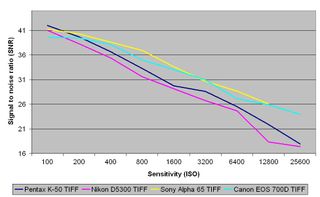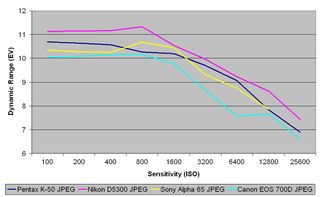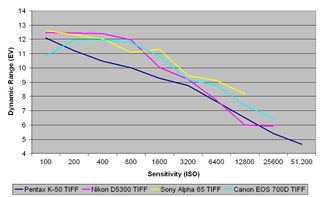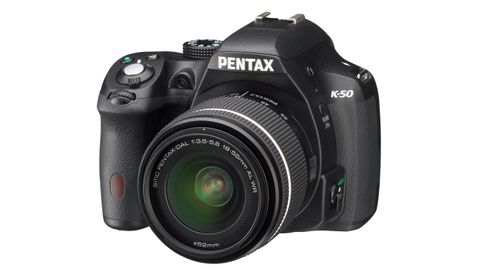Why you can trust TechRadar
We shoot a specially designed chart in carefully controlled conditions and the resulting images are analysed using DXO Analyzer software to generate the data to produce the graphs below.
A high signal to noise ratio (SNR) indicates a cleaner and better quality image.
For more more details on how to interpret our test data, check out our full explanation of our noise and dynamic range tests.
Here we compare the Pentax K-50 with the Nikon D5300, Sony Alpha 65 and Canon 700D.
JPEG signal to noise ratio

The K-50 performs very well in the signal-to-noise ratio test, beating the other cameras at the lower end of the sensitivity run (although it dips at ISO 200 to match the others). At the very top end of the scale, such as ISO 12800, it is a decent performer, if not quite the best on test.
Raw signal to noise ratio

In raw format (after conversion to TIFF), the K-50 performs slightly worse in the signal to noise ratio tests. Here we can see it is very closely tied to the Nikon D5300, this could be because they both use a Sony sensor. The other two cameras put in a very similar performance, while they are all pretty consistent.
JPEG dynamic range

The K-50 puts in a good, consistent performance for dynamic range, being the second best performer at the very lowest end of the sensitivity run. In the middle of the range it is very closely tied to the Sony Alpha 65and the Canon EOS 700D. The Nikon D5300 puts in the best performance in the test though.
Raw dynamic range

The K-50's raw format files (after conversion to TIFF) have lower scores than the other cameras on test at most sensitivities. This may be a result of the camera favouring detail over noise reduction though for raw format files. As usual, however, you can apply your own noise reduction in post-processing.
Current page: Noise and dynamic range
Prev Page Image quality and resolution Next Page Sample imagesAmy has been writing about cameras, photography and associated tech since 2009. Amy was once part of the photography testing team for Future Publishing working across TechRadar, Digital Camera, PhotoPlus, N Photo and Photography Week. For her photography, she has won awards and has been exhibited. She often partakes in unusual projects - including one intense year where she used a different camera every single day. Amy is currently the Features Editor at Amateur Photographer magazine, and in her increasingly little spare time works across a number of high-profile publications including Wired, Stuff, Digital Camera World, Expert Reviews, and just a little off-tangent, PetsRadar.

Steve Jobs was wrong about the post-PC era and the next batch of iPads should embrace this

Soundcore's new sports earbuds offer a Powerbeats Pro-style customizable secure fit for a fraction of the price

Meta’s massive OS announcement is more exciting than a Meta Quest 4 reveal, and VR will never be the same again

